Social Psychology
1/107
Earn XP
Description and Tags
Block one 2024 social psychology
Name | Mastery | Learn | Test | Matching | Spaced |
|---|
No study sessions yet.
108 Terms
social comparison theory
The theory that people evaluate their own abilities and opinions by comparing themselves to others.
two-factor theory of emotion
The theory that the experience of emotion is based on two factors: physiological arousal and a cognitive interpretation of that arousal.
six “primary” emotions
happiness, sadness, anger, fear, surprise, and disgust
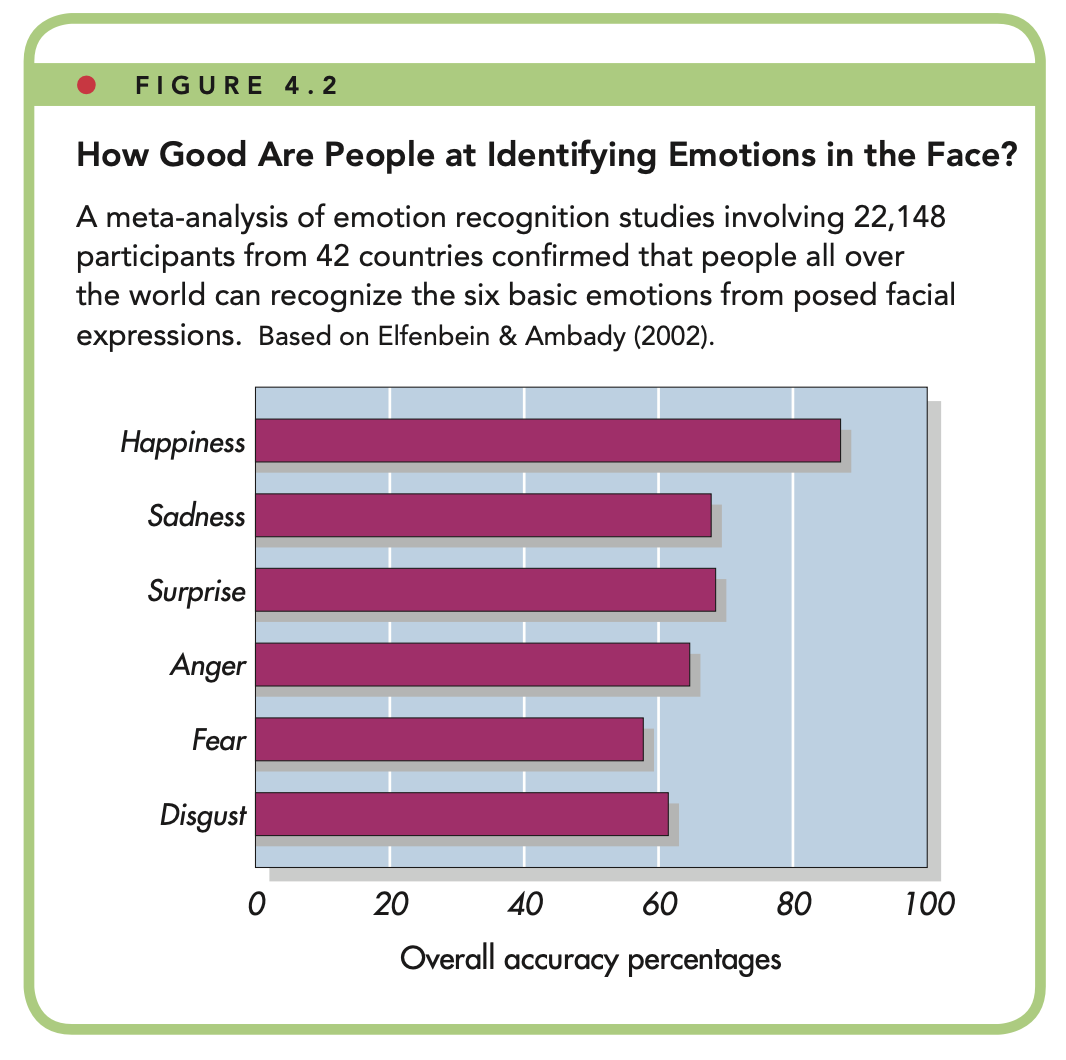
The bystander effect
The effect whereby the presence of others inhibits helping.
The Five Steps to Helping in an Emergency
Noticing, Interpreting, Taking responsibility, Deciding how to help, Providing help
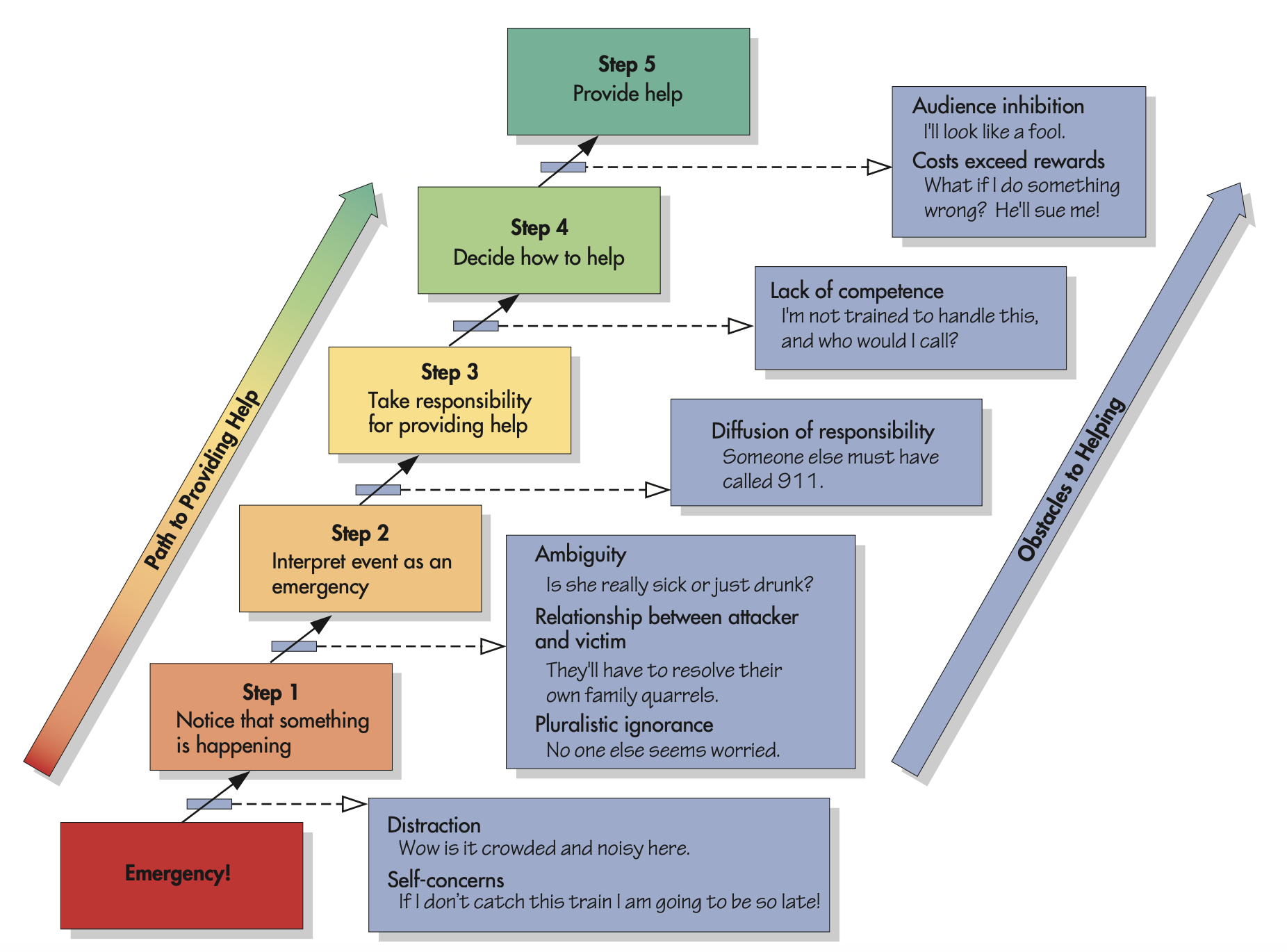
pluralistic ignorance
The state in which people in a group mistakenly think that their own individual thoughts, feelings, or behaviors are different from those of the others in the group.
diffusion of responsibility
The belief that others will or should take the responsibility for providing assistance to a person in need.
audience inhibition
Reluctance to help for fear of making a bad impression on observers
identity fusion
A strong sense of “oneness” and shared identity with a group and its individual members.
conformity
The tendency to change our perceptions, opinions, or behavior in ways that are consistent with social or group norms.
informational influence
Influence that produces conformity when a person believes others are correct in their judgments.
normative influence
Influence that produces conformity when a person fears the negative social consequences of appearing deviant.
private conformity
The change of beliefs that occurs when a person privately accepts the position taken by others.
public conformity
A superficial change in overt behavior without a corresponding change of opinion that is produced by real or imagined group pressure.
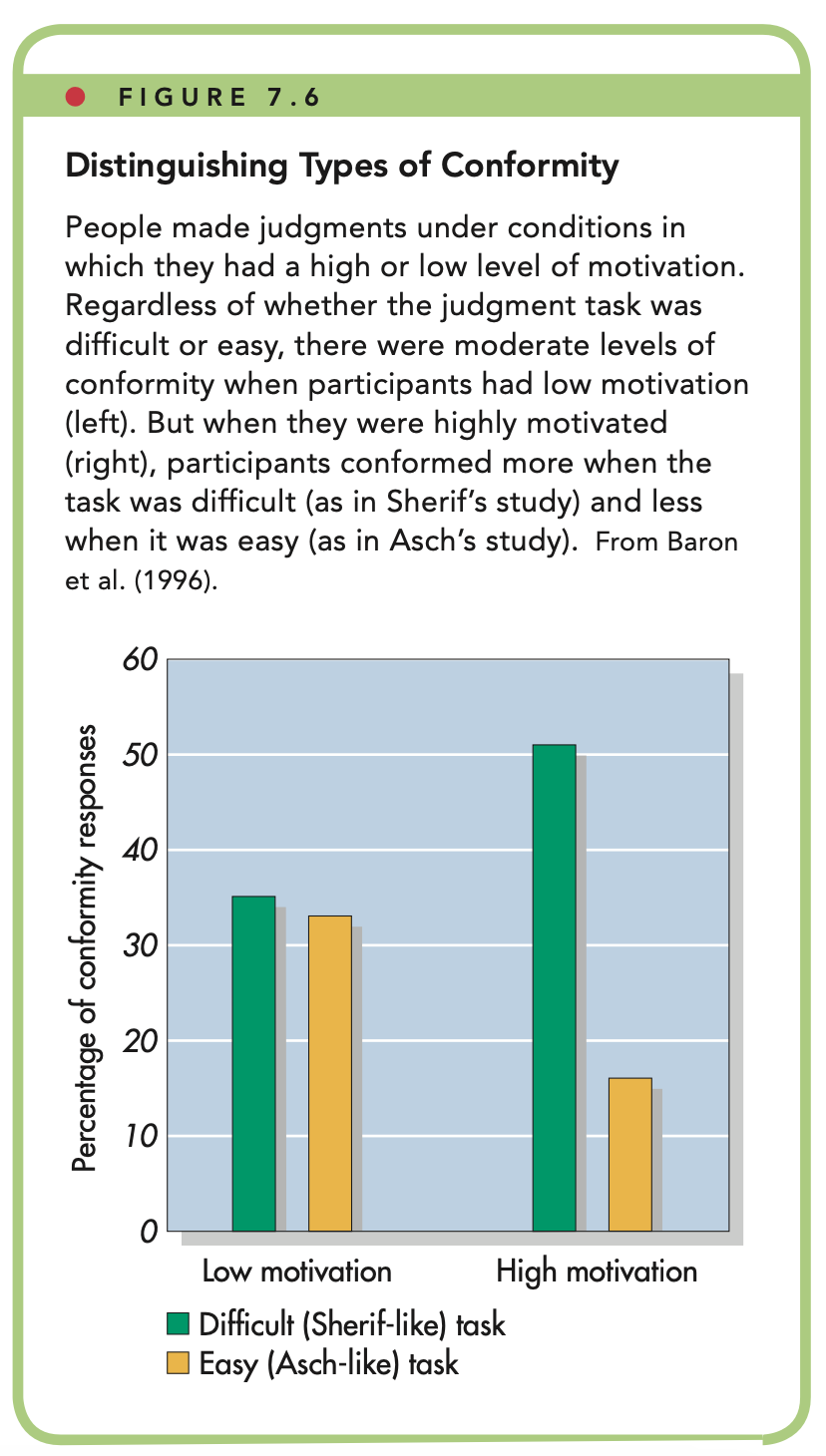
obedience
Behavior change produced by the commands of authority.
social impact theory
The theory that social influence depends on the strength, immediacy, and number of source persons relative to target persons.
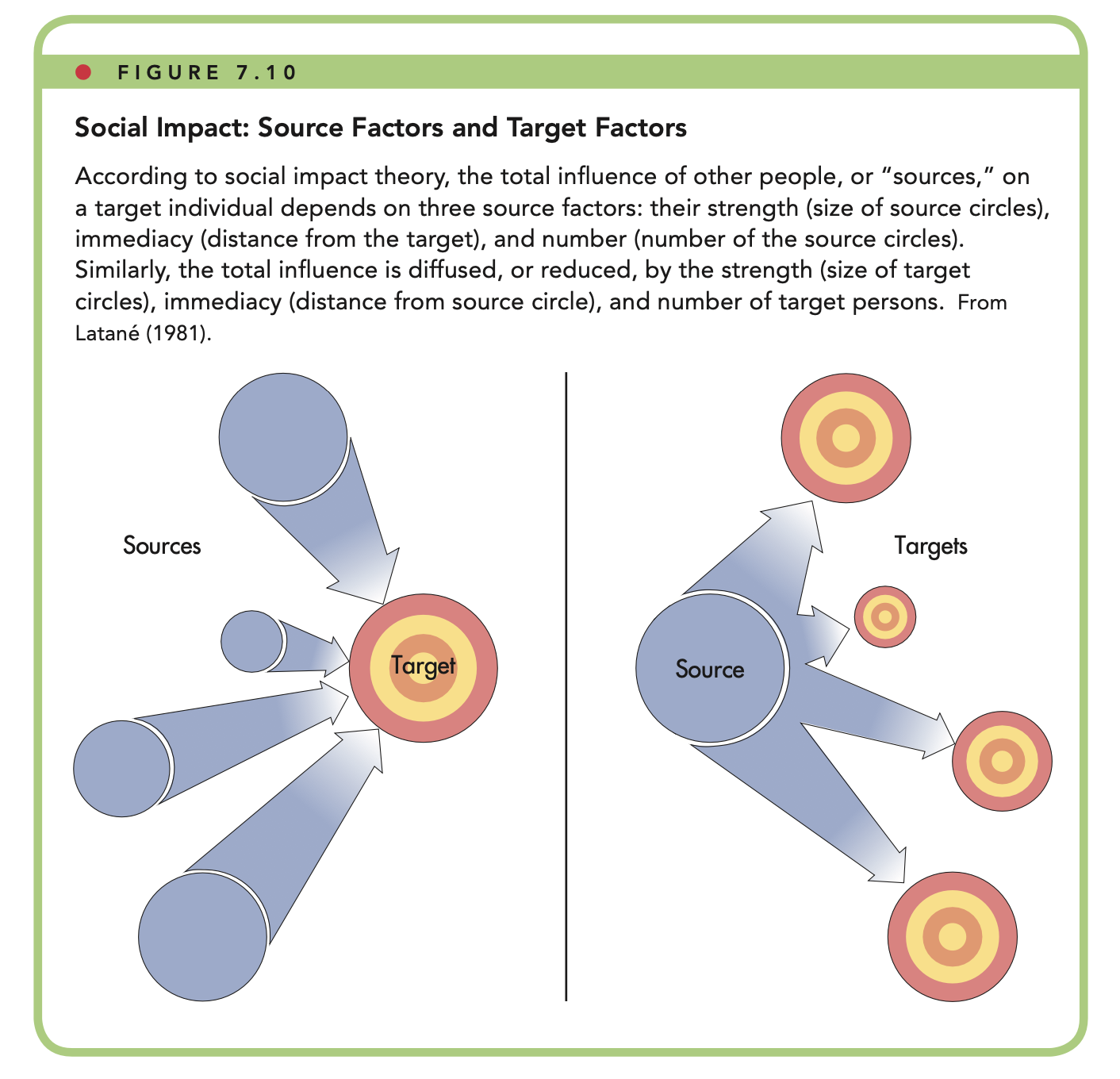
need for cognition
A personality variable that distinguishes people on the basis of how much they enjoy effortful cognitive activities.
sleeper effect
A delayed increase in the persuasive impact of a non-credible source.
peripheral route to persuasion
The process by which a person does not think carefully about a communication and is influenced instead by superficial cues.
central route to persuasion
The process by which a person thinks carefully about a communication and is influenced by the strength of its arguments.
inoculation hypothesis
The idea that exposure to weak versions of a persuasive argument increases later resistance to that argument.
psychological reactance
The theory that people react against threats to their freedom by asserting themselves and perceiving the threatened freedom as more attractive.
cognitive dissonance theory
Theory holding that inconsistent cognitions arouses psychological tension that people become motivated to reduce.
insufficient justification
A condition in which people freely perform an attitude-discrepant behavior without receiving a large reward.
insufficient deterrence
A condition in which people refrain from engaging in a desirable activity, even when only mild punishment is threatened.
The four steps to attitude change, caused by cognitive dissonance
Unwanted negative consequences, personal responsibility, physiological arousal, attribution of arousal to behavior
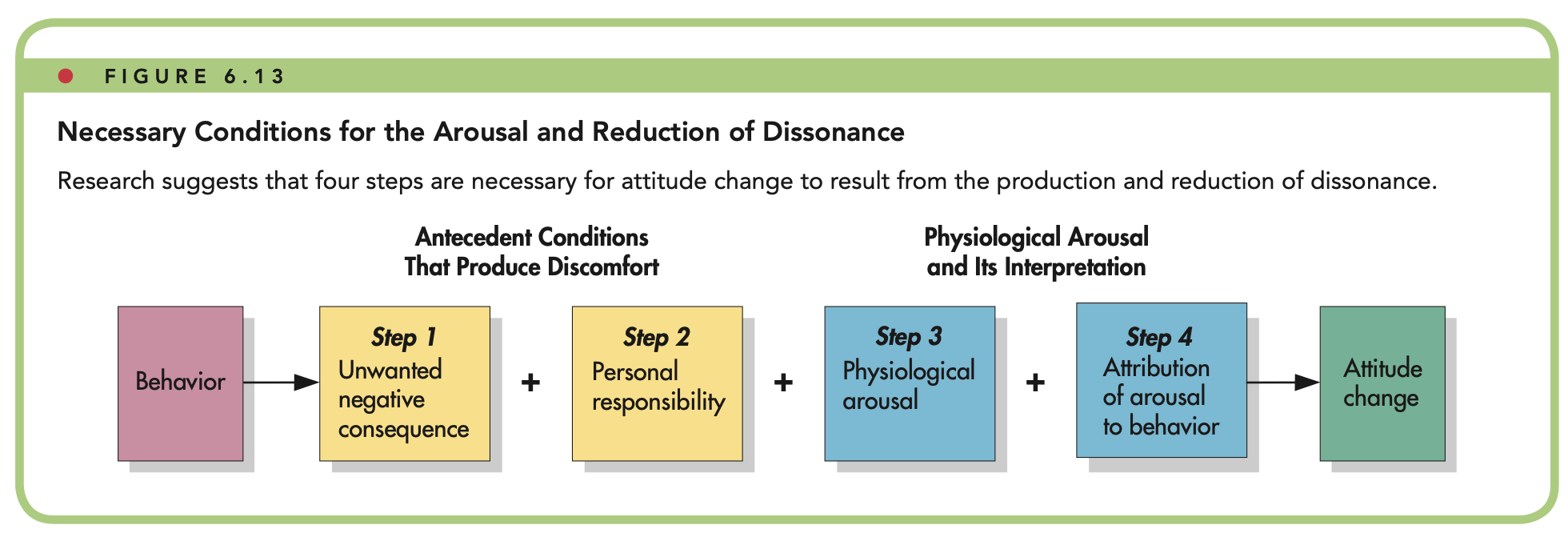
self-perception theory
We infer how we feel by observing ourselves and the circumstances of our own behavior. This sort of self-persuasion is not fueled by the need to reduce tension or justify our actions. Instead, it is a cool, calm, and rational process in which people interpret ambiguous feelings by observing their own behavior.
impression-management theory
A theory stating that what matters is not a motive to be consistent but rather a motive to appear consistent.
self-affirmation theory
Acts that arouse dissonance do so because they threaten the self-concept, making the person feel guilty, dishonest, or hypocritical and motivating a change in attitude or future behavior.
moral licensing
a tendency to justify an anticipated misdeed by citing good things that we have done.
social facilitation
A process whereby the presence of others enhances performance on easy tasks but impairs performance on difficult tasks.
Zajonc’s three step model to social facilitation
The presence of others creates general physiological arousal, which energizes behavior.
Increased arousal enhances an individual’s tendency to perform the dominant response.
The quality of an individual’s performance varies according to the type of task
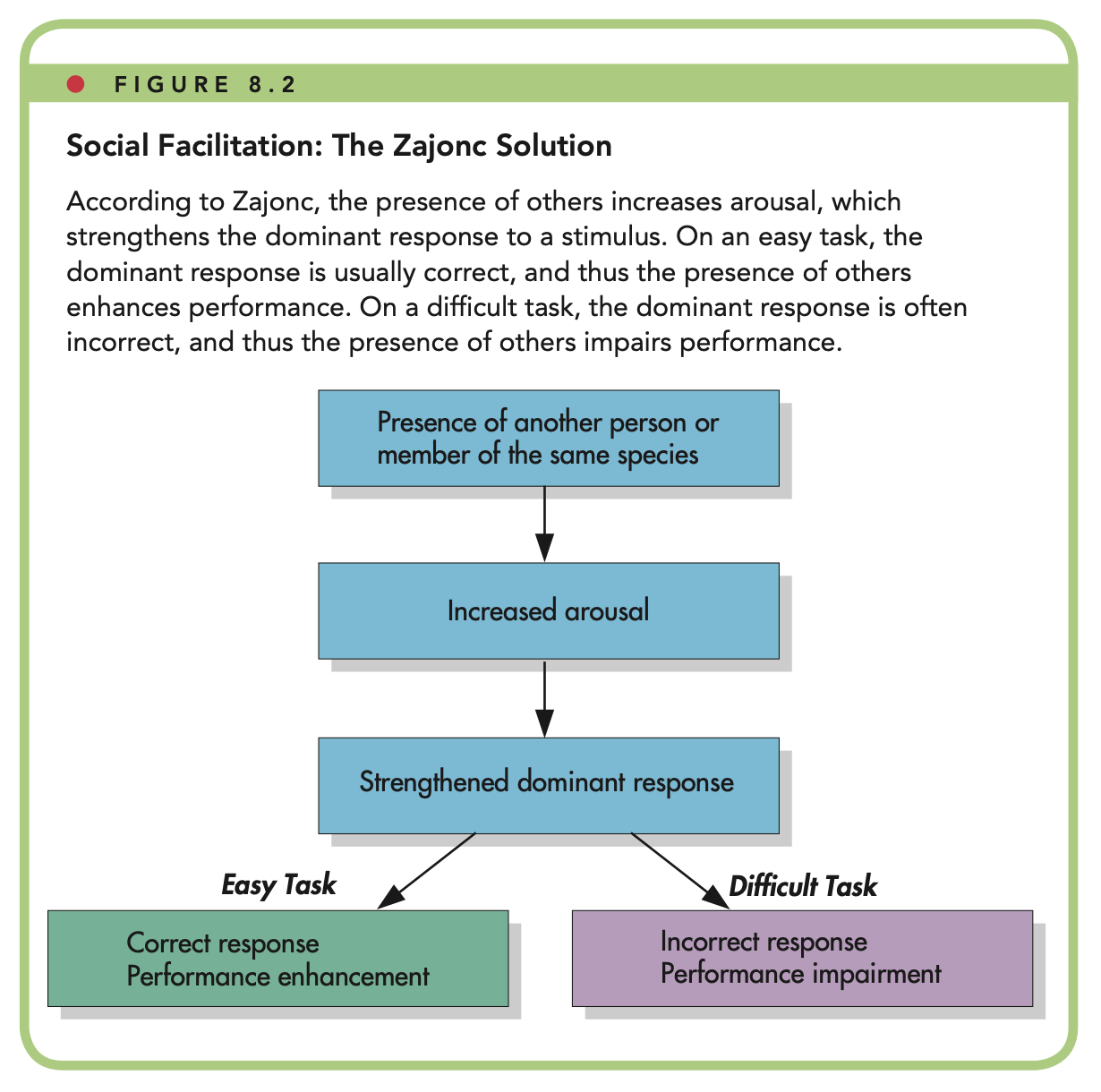
mere presence
The proposition
that the mere presence of others is sufficient to produce social facilitation effects.
evaluation apprehension theory
A theory that the presence of others will produce social facilitation effects only when those others are seen as potential evaluators.
distraction-conflict theory
A theory that the presence of others will produce social facilitation effects only when those others distract from the task and create attentional conflict.
social loafing
A group-produced reduction in individual output on tasks where contributions are pooled.
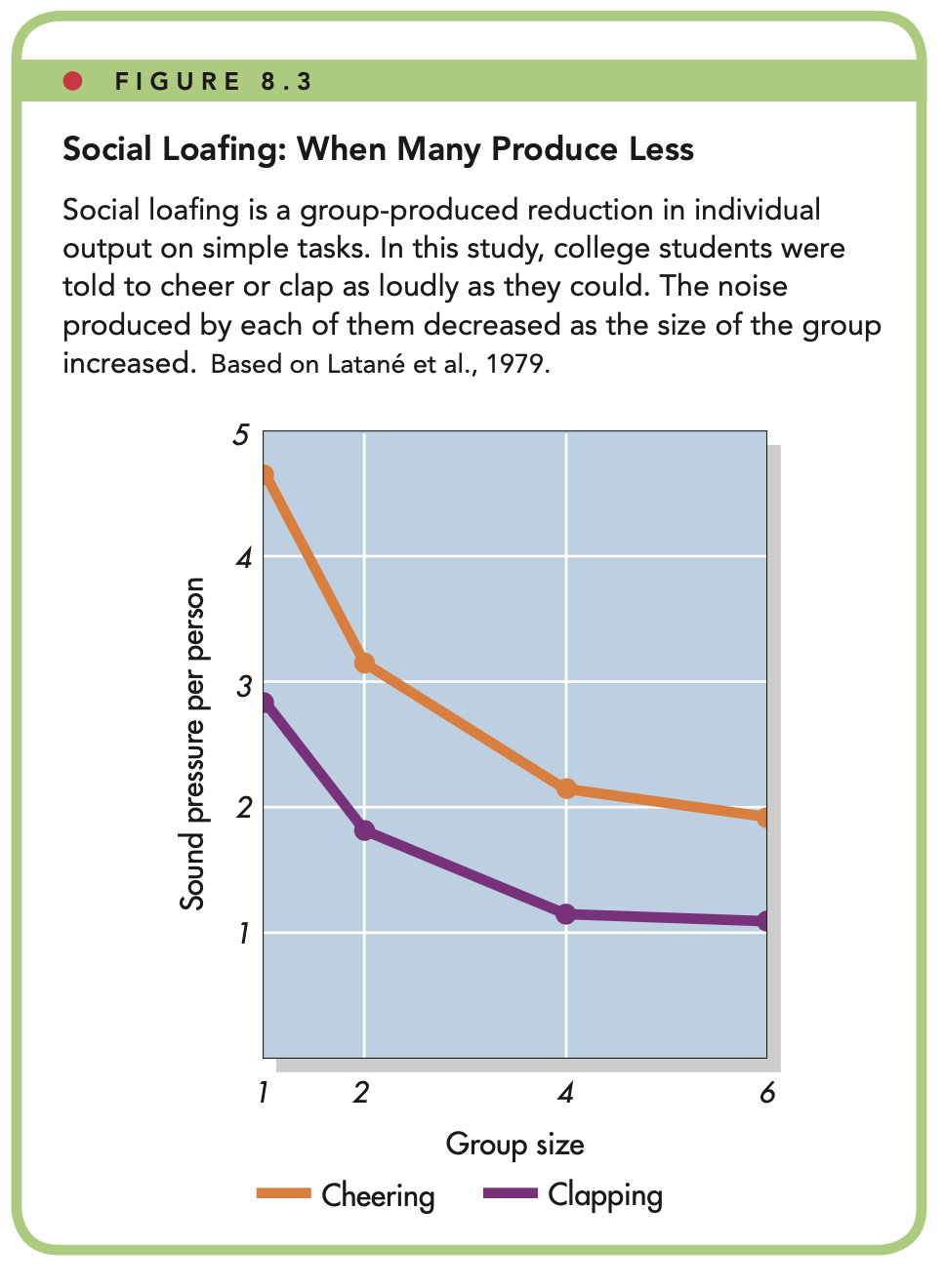
collective effort model
The theory that individuals will exert effort on a collective task to the degree that they think their individual efforts will be important, relevant, and meaningful for achieving outcomes that they value.
social compensation
increasing the effort on collective tasks to try to compensate for the anticipated social loafing or poor performance of other group members.
deindividuation
The loss of a person’s sense of individuality and the reduction of normal constraints against deviant behavior. Arousal, anonymity, and reduced feelings of individual responsibility together contribute to deindividuation.
social identity model of deindividuation effects (SIDE)
Whether deindividuation affects people for better or for worse reflects the characteristics and norms of the group immediately surrounding the individual as well as the group’s power to act according to these norms.
dispositions
stable characteristics such as personality traits, attitudes, and abilities.
attribution theory
A group of theories that describe how people explain the causes of behavior.
personal attribution
Attribution to internal characteristics of an actor, such as ability, personality, mood, or effort.
situational attribution
Attribution to factors external to an actor, such as the task, other people, or luck.
Jones’s Correspondent Inference Theory
People try to infer from an action whether the act corresponds to an enduring personal trait of the actor.
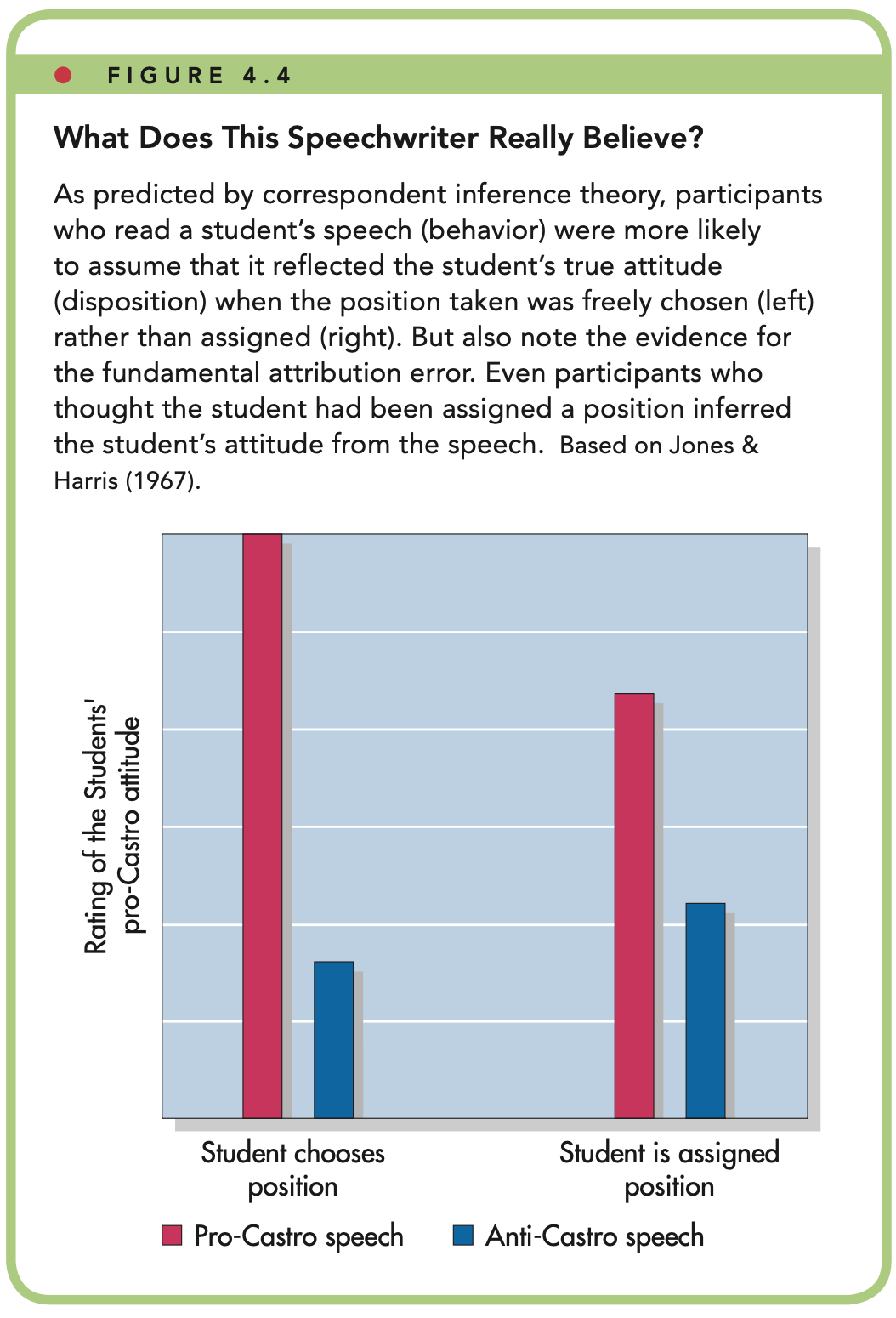
The three factors that people base their inferences on, according to Jones’s correspondent inference theory.
Choice - Behavior that is freely chosen is more informative about a person than behavior that is coerced by the situation.
Expectedness - An action tells us more about a person when it departs from the norm
Intended effects - Acts that produce many desirable outcomes do not reveal a person’s specific motives as clearly as acts that produce only a single desirable outcome.
Kelley’s Covariation Theory
People make attributions by using the covariation principle. Three kinds of covariation information in particular are useful: consensus, distinctiveness, and consistency
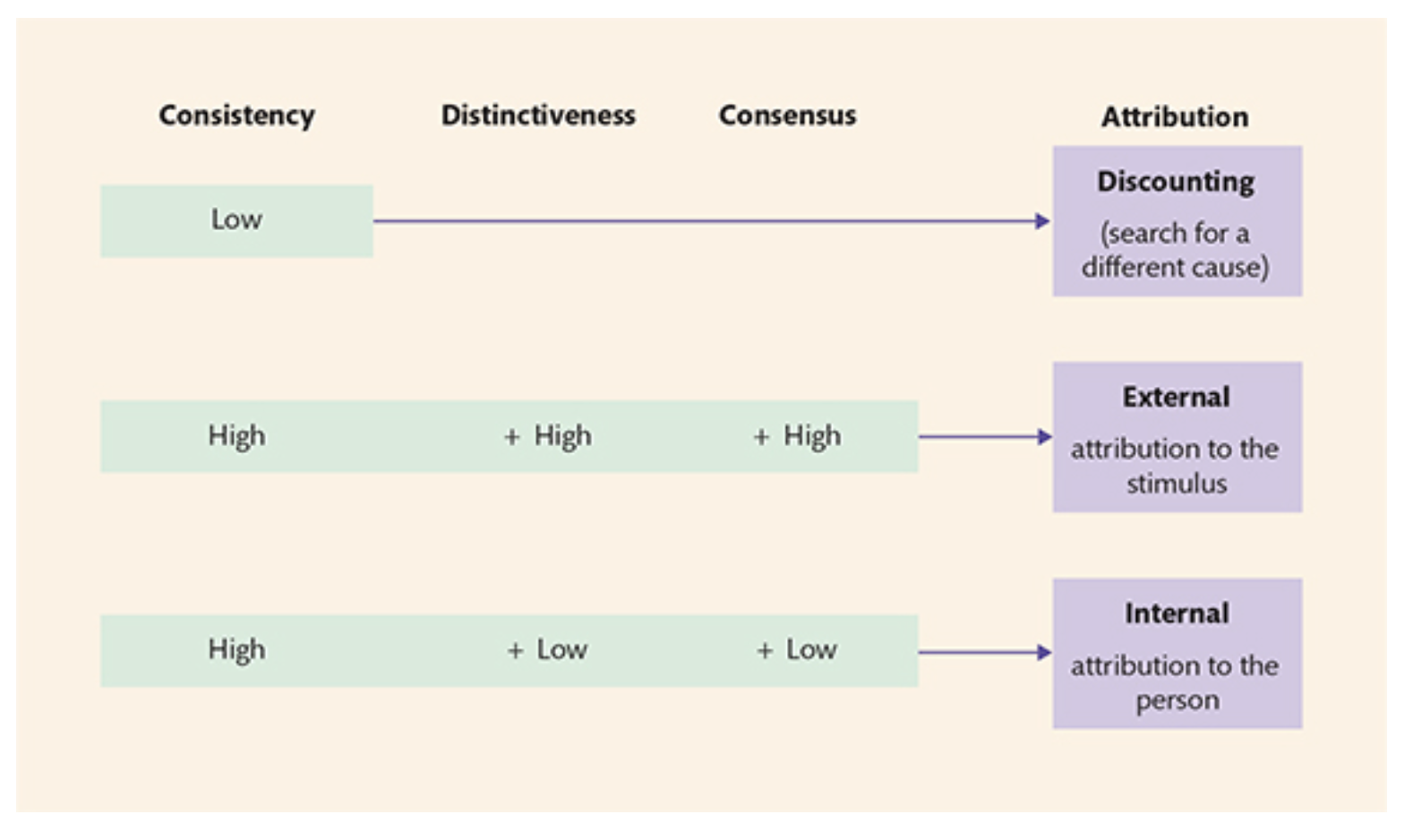
covariation principle
A principle of attribution theory that holds that people attribute behavior to factors that are present when a behavior occurs and are absent when it does not.
availability heuristic
The tendency to estimate the likelihood that an event will occur by how easily instances of it come to mind.
false-consensus effect
The tendency for people to overestimate the extent to which others share their opinions, attributes, and behaviors.
base-rate fallacy
The finding that people are relatively insensitive to consensus information presented in the form of numerical base rates.
counterfactual thinking
The tendency to imagine alternative events or outcomes that might have occurred but did not.
fundamental attribution error
The tendency to focus on the role of personal causes and underestimate the impact of situations on other people’s behavior.

belief in a just world
The belief that individuals get what they deserve in life, an orientation that leads people to disparage victims.
confirmation bias
The tendency to seek, interpret, and create information that verifies existing beliefs.
belief perseverance
The tendency to maintain beliefs even after they have been discredited.
self-fulfilling prophecy
The process by which one’s expectations about a person eventually lead that person to behave in ways that confirm those expectations.
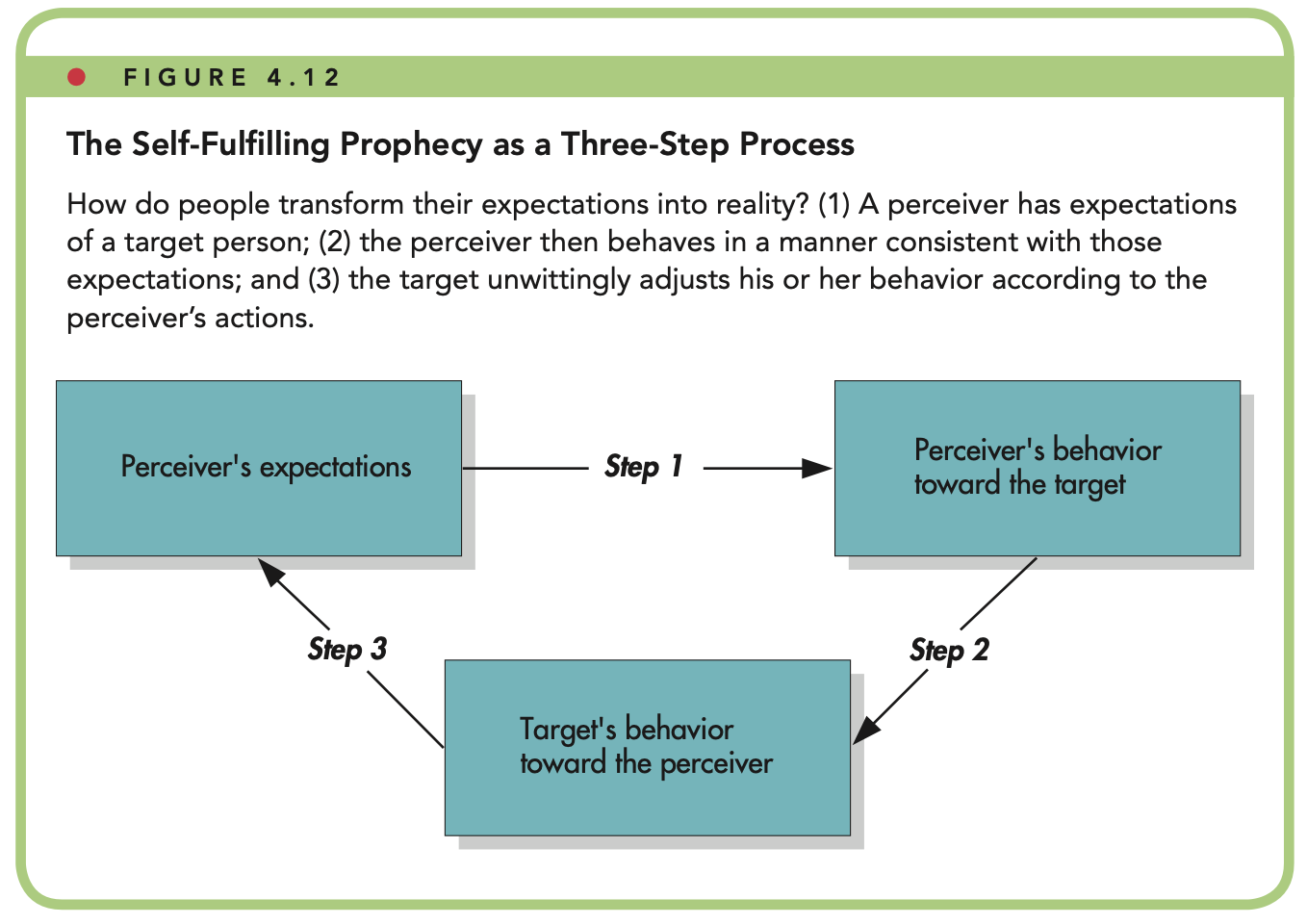
stereotype
A belief or association that links a whole group of people with certain traits or characteristics.
prejudice
Negative feelings toward persons based on their membership in certain groups.
discrimination
Behavior directed against persons because of their membership in a particular group.
social categorization
The classification of persons into groups on the basis of common attributes.
outgroup homogeneity effect
The tendency to assume that there is greater similarity among members of outgroups than among members of ingroups.
social dominance orientation
A desire to see one’s ingroup as dominant over other groups and a willingness to adopt cultural values that facilitate oppression over other groups.
system justification theory
A theory that proposes that people are motivated (at least in part) to defend and justify the existing social, political, and economic conditions.
superordinate goal
A shared goal that can be achieved only through cooperation among individuals or groups.
realistic conflict theory
The theory that hostility between groups is caused by direct competition for limited resources.
relative deprivation
Feelings of discontent aroused by the belief that one fares poorly compared with others.
in-group favoritism
The tendency to discriminate in favor of ingroups over outgroups.
social identity theory
The theory that people favor ingroups over outgroups in order to enhance their self-esteem.

contact hypothesis
The theory that direct contact between hostile groups will reduce intergroup prejudice under certain conditions.
The four conditions for contact hypothesis
Equal status
Personal interaction
Cooperative activities
Social norms
hedonic relevance
Refers to behaviour that has important direct consequences for self.
outcome bias
Belief that the outcomes of a behaviour were intended by the person who chose the behaviour.
correspondence bias
A general attribution bias in which people have an inflated tendency to see behaviour as reflecting (corresponding to) stable underlying personality attributes. Very similar, but not identical to fundamental attribution error
actor-observer effect
It refers to the tendency for people to attribute others' behaviour internally to dispositional factors and their own behaviour externally to environmental factors.
self-serving biases
Attributional distortions that protect or enhance self-esteem or the self-concept.
self-handicapping
Publicly making advance external attributions for our anticipated failure or poor performance in a forthcoming event.
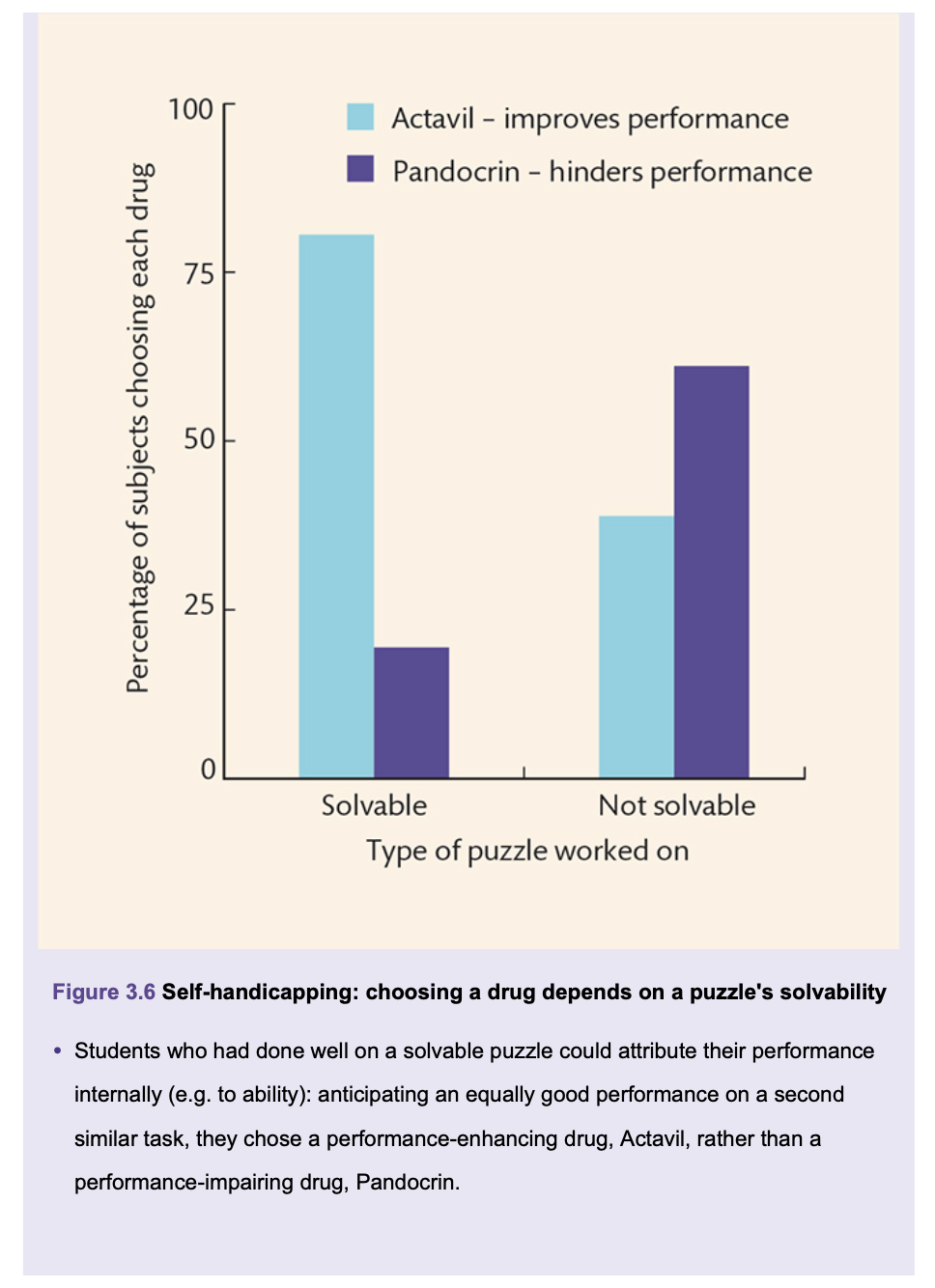
ethnocentrism
Evaluative preference for all aspects of our own group relative to other groups.
ultimate attribution error
Tendency to attribute bad outgroup and good ingroup behaviour internally, and to attribute good outgroup and bad ingroup behaviour externally.
common sense theory of emotion
stimulus -> emotion -> bodily arousal
Cannon-Bard theory of emotion
bodily arousal & emotion at once
James-Lange theory of emotion
stimulus -> bodily arousal -> emotion
two-factor / Schachter-Singer theory of emotion
stimulus -> bodily arousal -> cognitive attribution -> emotion
need for affiliation
The desire to establish and maintain many rewarding interpersonal relationships.
The three types loneliness
Intimate loneliness - is felt when someone wants but does not have a spouse, significant other, or best friends to rely on for emotional support, especially during personal crises
Relational loneliness - is felt when someone wants but lacks friendships from school and work and family connections
Collective loneliness - comes from remote relationships and the social identities we derive from, say, alumni of the schools we have attended and clubs we join on the basis of common needs or interests.

mere exposure effect
The phenomenon whereby the more often people are exposed to a stimulus, the more positively they evaluate that stimulus.
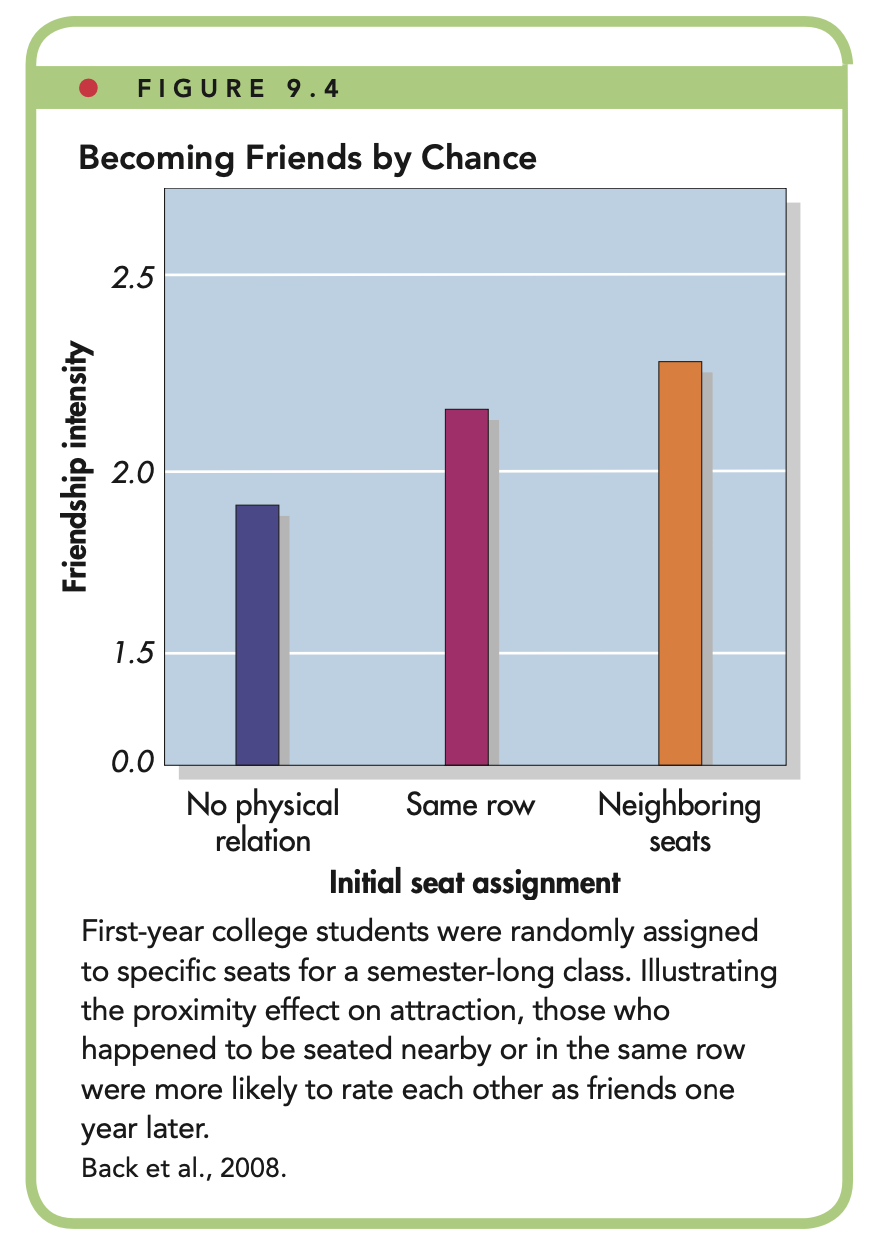
group attractiveness effect
The perceived physical attractiveness of a group as a whole is greater than the average attractiveness of its individual members.
what-is-beautiful-is-good stereotype
The belief that physically attractive individuals also possess desirable personality characteristics.
Two-Stage Model of the Attraction Process
The two-stage model of attraction holds that we first avoid dissimilar others and then approach similar others.
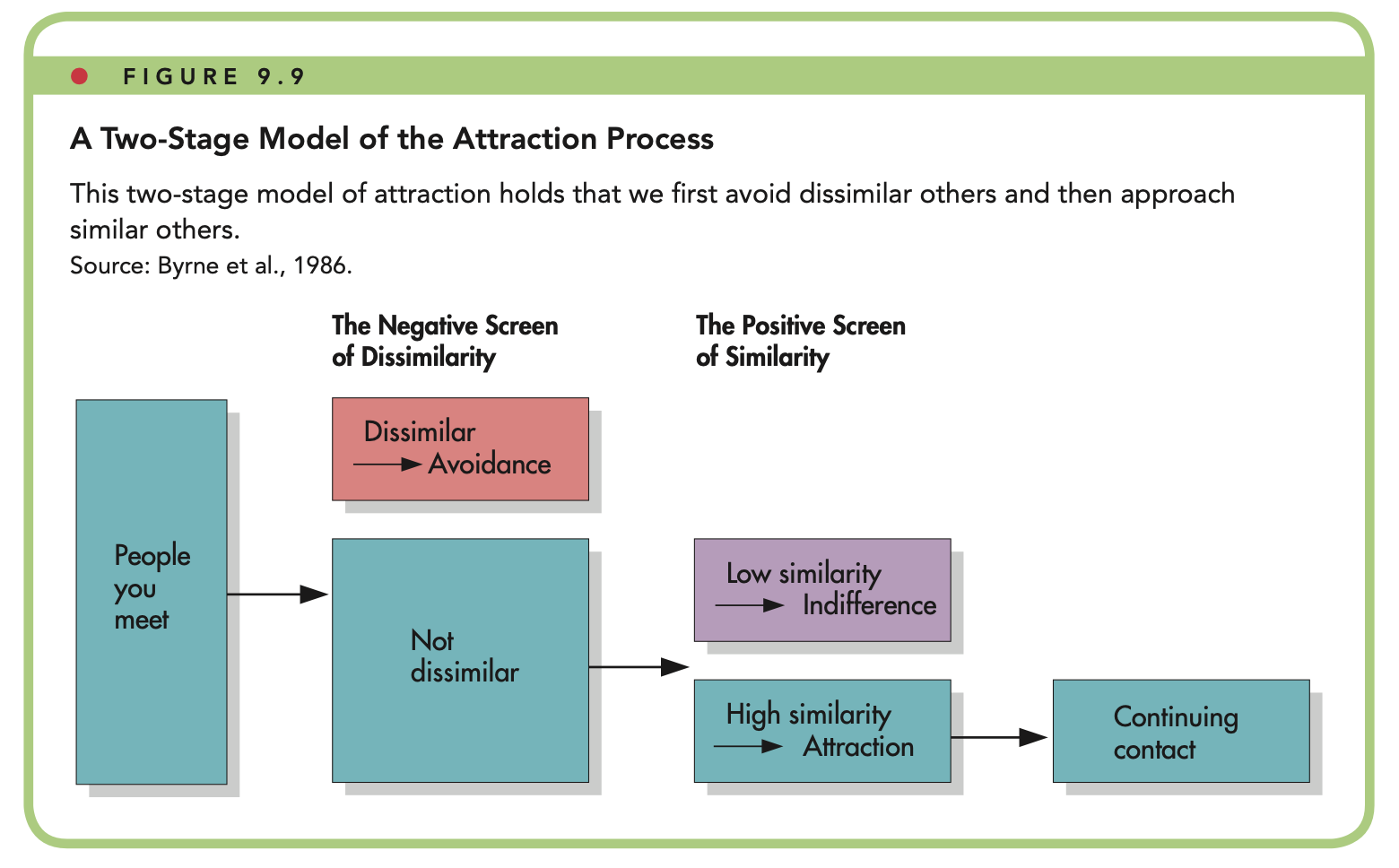
matching hypothesis
The proposition that people are attracted to others who are similar in physical attractiveness.
hard-to-get effect
The tendency to prefer people who are highly selective in their social choices over those who are more readily available.
intimate relationship
A close relationship between two adults involving emotional attachment, fulfillment of psychological needs, or interdependence.
stimulus– value–role (SVR) theory
stimulus stage
value stage
role stage
social exchange theory
A perspective that views people as motivated to maximize benefits and minimize costs in their relationships with others.
equity theory
The theory that people are most satisfied with a relationship when the ratio between benefits and contributions is similar for both partners.

exchange relationship
A relationship in which the participants expect and desire strict reciprocity in their interactions.
communal relationship
A relationship in which the participants expect and desire mutual responsiveness to each other’s needs.
attachment styles
The way a person typically interacts with significant others.
Secure
Anxious
Avoidant
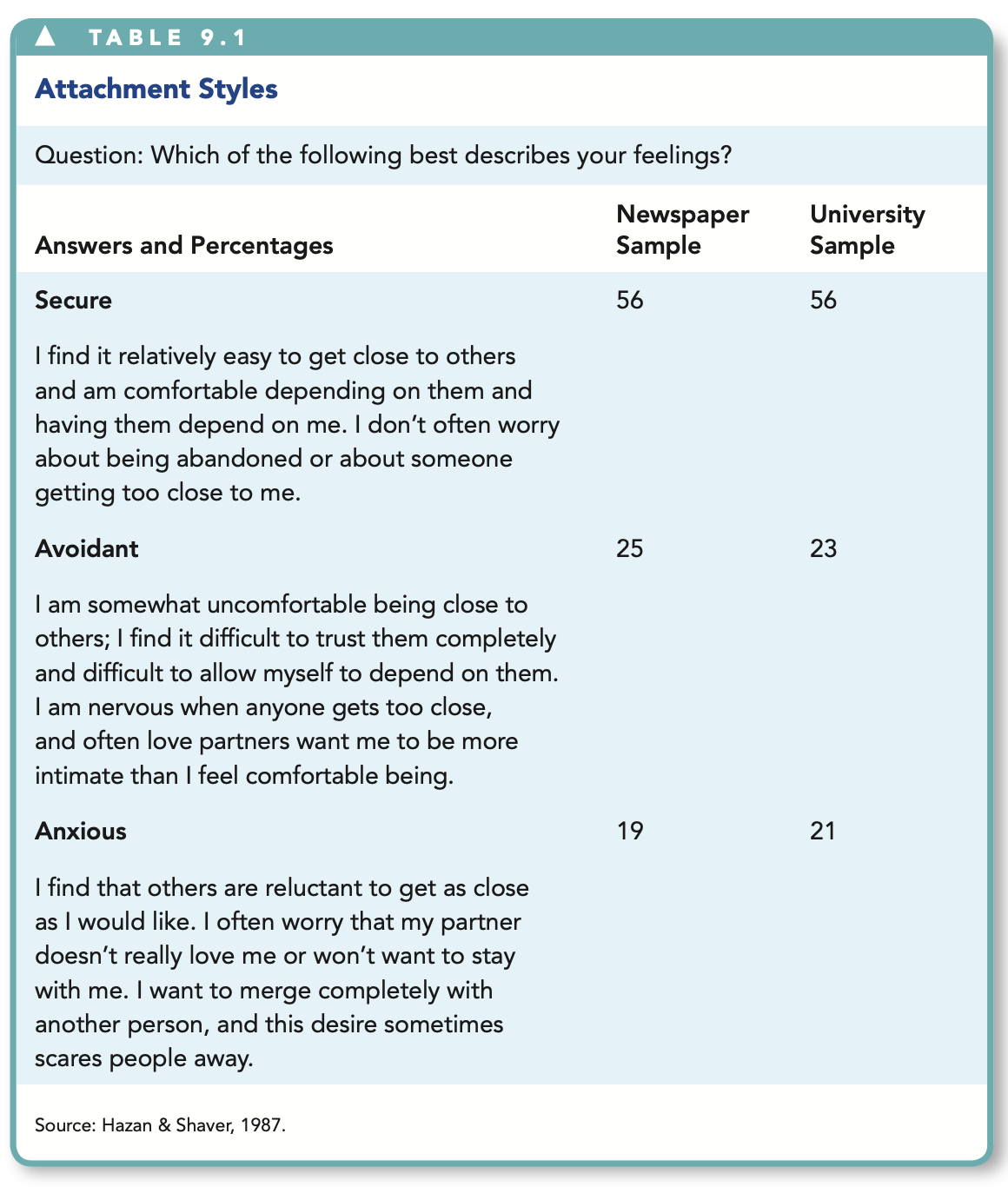
triangular theory of love
A theory proposing that love has three basic components—intimacy, passion, and commitment—that can be combined to produce eight subtypes.
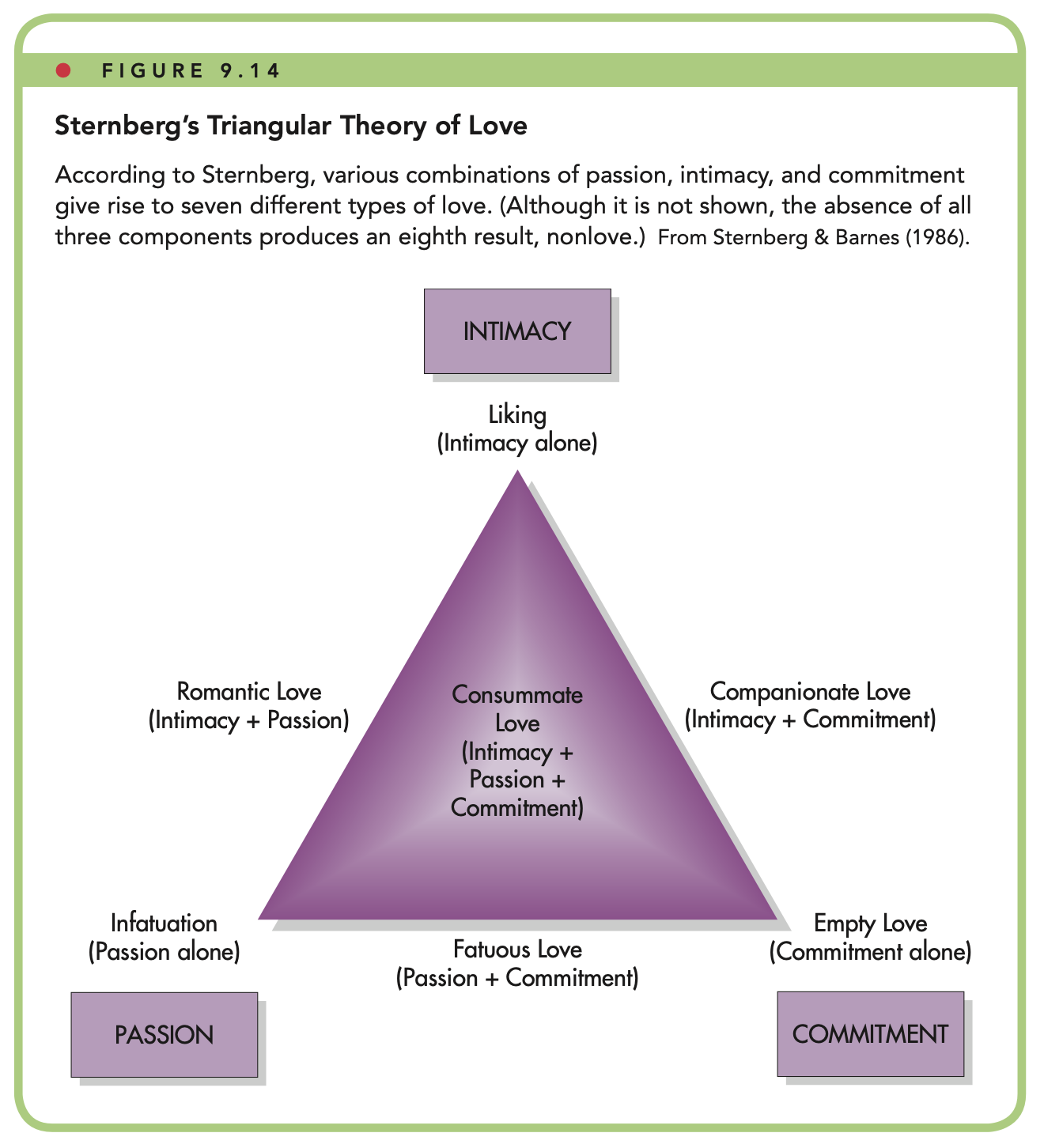
passionate love
Romantic love characterized by high arousal, intense attraction, and fear of rejection.